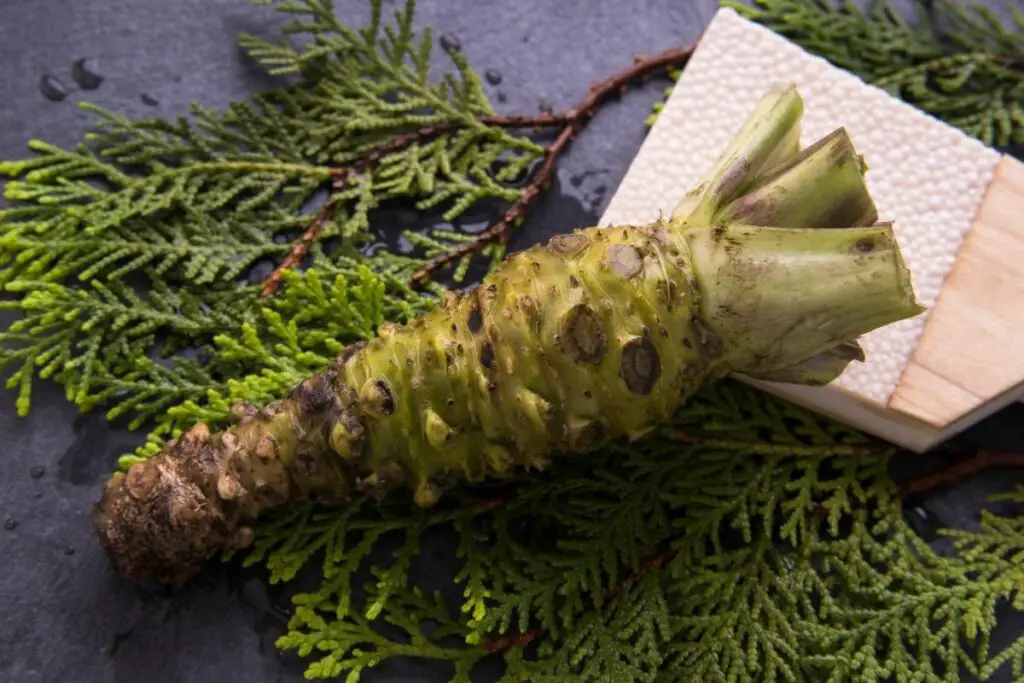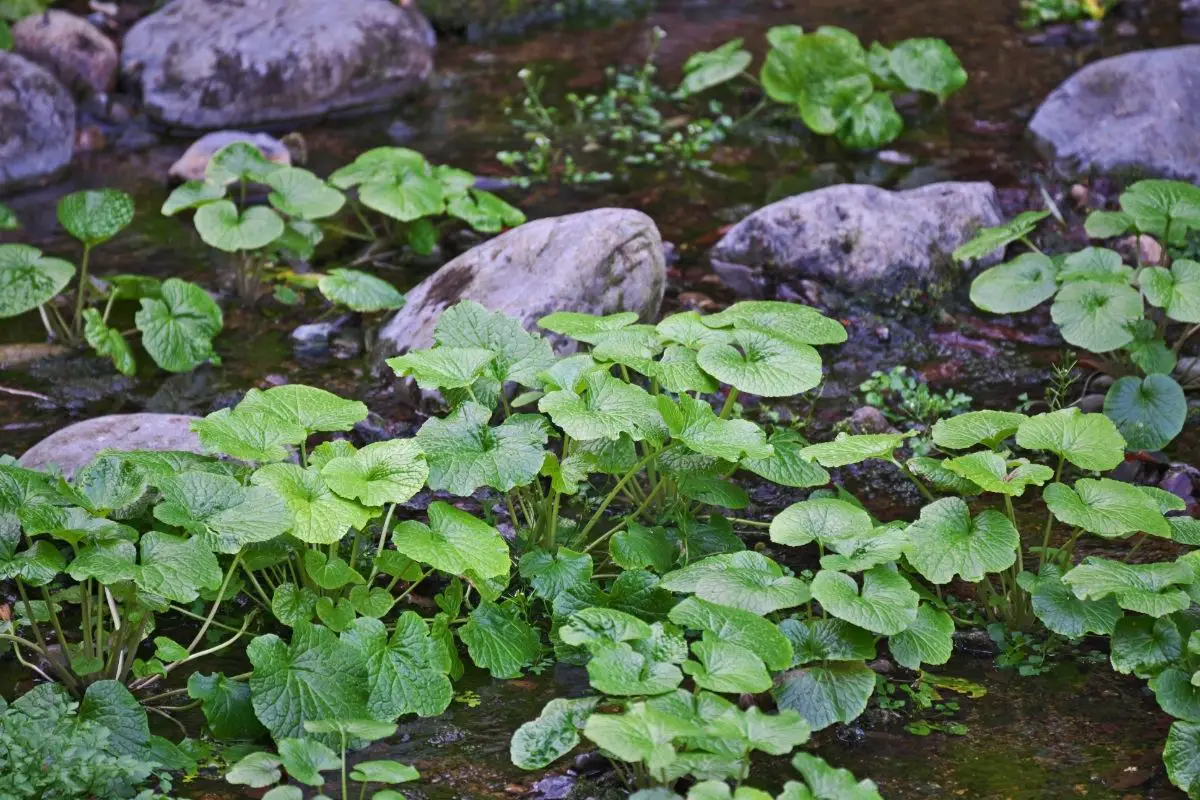Are you a fan of all things strong and spicy? If you love anything that gets your taste buds tingling and your eyes streaming, you’ll love wasabi.

If you’re already a wasabi lover, why not take things one step further and learn how to grow this remarkable plant in your home or yard? Wasabi has a notoriously tricky temperament (see also, ‘Why is Wasabi so Expensive?‘). It’s a challenging plant to grow, but you can learn in no time with patience and the right knowledge.
Ready to learn more? Stick with us to find everything you need to know about growing wasabi.
What Is Wasabi?
Have you ever ordered a poke bowl? Ever wondered what that light green paste is sitting next to it? That’s wasabi. Well, it’s called wasabi. The truth is, most people have never tried real wasabi, even if they think they have.
Wasabi is a hot, spicy green paste. It’s usually served as a condiment, and it’s most commonly offered with sushi dishes.
Wasabi can be used to spice up almost any recipe, and its refreshing burst of quickly fading heat is strong but delicate enough to complement the flavors of your dish.
Wasabi is made from the rhizome (aka the root), and its signature spicy punch comes from the allyl isothiocyanate, an aliphatic isothiocyanate found in vegetables from the Brassica family.
This has also been used to treat pain, blood circulation issues, and rheumatic arthralgia. Interestingly, this is what makes the heat of wasabi taste so different. If you’ve ever tried wasabi, you’ll know you’ll feel the heat more up your nose than anywhere else!
Although wasabi is spicy, it’s essentially a root, not a pepper. This means it can’t be measured on the Scoville scale. However, if you want an average estimate to work with, most people agree it’s somewhere around the 10,000 Scovilles range!
Wasabi: Growing Conditions
Naturally, wasabi grows in shady conditions. It’s usually found growing wild in northern Japan, Korea, China, and New Zealand.
The wasabi plant is famously hard to cultivate. Even in ideal conditions, the wasabi plant is prone to disease. Wasabi grows by shady river banks high in the Japanese mountains in the wild.
For this reason, the plant has evolved to survive in low light conditions. It prefers moist (but not wet) soil and thrives in temperatures between 45 and 75 degrees Fahrenheit.
If these conditions match those in your yard or garden, you can plant wasabi in the spring!
How To Grow Wasabi In Your Garden

Want to learn more about growing wasabi in your garden? Let’s take a look at everything you need to know.
Wasabi may have a reputation for being a challenging grow, but the truth is, there are only a few things you need to know to pull it off successfully.
Full Shade
If you’re growing wasabi in your backyard, you’ll need to place it in full shade.
If your yard isn’t naturally shady, you can grow wasabi beneath the shade of another tree or in a cool corner of your porch – anywhere with plenty of shade. If your wasabi plant gets too much sunlight, you can expect it to droop and suffer quickly.
Moist Soil
f you really want your wasabi plant to thrive, you’ll need to keep the soil moist. However, wasabi is NOT an aquatic plant. If you drench your soil too much and leave it to sit in standing water, it will die fast. Keep your soil well-drained and consistently moist for best results.
When you plant your wasabi, plant it deep enough only to keep it upright. When all the roots are covered, begin to backfill the hole and subtly press the soil into place.
If you’re planting more than one wasabi plant, keep them between 12 inches apart. Wasabi plants can grow up to 24 inches tall, so giving each plant enough room to grow is essential.
Remember: Do NOT cover the rhizome. The rhizome needs to be exposed above the surface of the soil.
Use Pots
If you want to make the growing process easier, you can plant wasabi in pots. Ideally, you should choose pots between one and two gallons deep.
Make sure you use quality potting soil – this will guarantee the best results all year round, even when the weather turns. If it gets too hot or too cold, simply bring your wasabi plant indoors.
Soil Depth And pH
If you’re planting your wasabi in a pot or container, you should work with around 10-12 inches of compost and ensure a soil depth of between 8-10 inches.
To grow wasabi successfully, you’ll need to keep a close eye on the pH of your soil. Wasabi prefers neutral or slightly acidic soil, with a pH of between 6-7.
Testing Soil pH
Want to know how to test your soil pH?
Use a hand shovel to collect a soil sample from between 4-6 inches beneath the surface. Once you’ve collected the soil, add half a cup of water to the sample and mix it together.
Now, add half a cup of vinegar to your sample. If the soil begins to fizzle or bubble, it has an alkaline pH. This reason happens when the vinegar meets the alkaline soil.
Collect another soil sample, add half a cup of water, and mix together to test for acidity. Now, add half a cup of baking soda. Now, if you see any pronounced bubbling or fizzing, your soil is acidic.
Additional Care Tips
If your leaves have been wilting for more than a week, they should be removed to deter pests and minimize the risk of disease.
Whether you’re planting in a container, bed, or pot, make sure you keep weeds at bay and use an all-purpose fertilizer that’s rich in sulfur. This will improve the flavor of the rhizome.
Harvesting Wasabi
If you’ve planted your wasabi in the best conditions, you can expect to harvest a rhizome of around 4 inches after 24 to 36 months.
However, you can harvest in the meantime. Feel free to collect leaf stems, flowers, and leaves that typically bloom in the early springtime. Be careful not to overharvest your plant, though. Although all parts of the wasabi plant are edible, overharvesting can slow the growth of the rhizome.
Final Thoughts
If you’re a spice fanatic, you’ll love wasabi. It’s a punchy, diverse condiment that pairs beautifully with many dishes, and its fast-fading heat will still give the chance to appreciate the full flavor of your dish.
Wasabi may be temperamental, but it’s not impossible to grow. With the right conditions and knowledge, you can grow your own at home, even if you’re not green-fingered!








